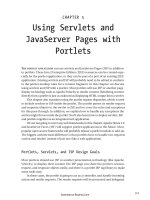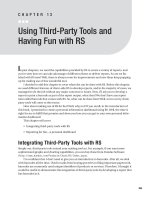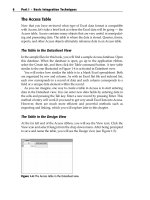moodle and office 365 with adfs
Bạn đang xem bản rút gọn của tài liệu. Xem và tải ngay bản đầy đủ của tài liệu tại đây (764.99 KB, 11 trang )
Moodle and Office 365 Step-by-Step
Guide: Federation using Active Directory
Federation Services
This document is provided “as-is”. Information and views expressed in this document, including URL and
other Internet Web site references, may change without notice. You bear the risk of using it.
Examples depicted herein are provided for illustration only and are fictitious. No real association or
connection is intended or should be inferred.
This document does not provide you with any legal rights to any intellectual property in any Microsoft
product. You may copy and use this document for your internal, reference purposes.
© 2013 Microsoft Corporation. All rights reserved.
© 2013 Microsoft Corporation. All rights reserved. Page 2
Moodle and Office 365 Step-by-Step
Guide: Federation using Active Directory
Federation Services
Adam Bradley, Architect
Microsoft Corporation
June 2013
Applies to: Office 365 | AD FS 2.0 | Windows Azure Active Directory
Summary: This guide walks you through the setup of a basic lab deployment of Moodle, Active Directory
Federation Services (AD FS) 2.0, and Windows Azure Active Directory to perform cross-product,
browser-based identity federation. This setup supports a federated single sign-on (SSO) experience for
Moodle and Office 365, in addition to user autoprovisioning, and user auto enrollment in Moodle
through Office 365.
Contents
About this guide 3
Terminology used in this guide 3
About the author 3
Prerequisites and other requirements 4
AD FS 2.0 4
Moodle 4
SimpleSAMLPHP 4
Moodle Plugins 7
Appendix A: Using AD FS 2.0 with SimpleSAMLPHP – Claim mapping rules 10
© 2013 Microsoft Corporation. All rights reserved. Page 3
About this guide
This guide provides step-by-step instructions for configuring a basic identity federation deployment
between Moodle and Office 365. This deployment uses federated identities and leverages the
capabilities of Microsoft® Active Directory® Federation Services 2.0 (AD FS 2.0), the Security Assertion
Markup Language (SAML) 2.0 protocol ( and SAML 2.0
HTTP POST binding (provided by the SimpleSAMLPHP authentication framework).
Objectives for this project:
Provide an Office 365 single sign-on experience for a Federated namespace via the AD FS Secure
Token Service (STS) where AD FS acts as the Identity Provider (IdP), and STS and Moodle (via
SimpleSAMLPHP) both act as the Service Provider (SP)
Use native Moodle extensions where possible
Support User autoprovisioning in Moodle
Support Course auto enrollment in Moodle
Terminology used in this guide
Throughout this document, there are numerous references to federation concepts that are called by
different names in the Microsoft and Shibboleth products. The following table assists in drawing
parallels between the two vendors’ technologies.
Table 1. Terminology differences
AD FS 2.0 name
Shibboleth name
Concept
Security token
Assertion
An XML document that is created and sent during a
federated access request that describes a user
Claims provider
Identity provider
(IdP)
A partner in a federation that creates security tokens for
users
Relying party
Service provider (SP)
A partner in a federation that consumes security tokens
to provide access to applications
Claims
Assertion attributes
Data about users that is sent inside security tokens
In this deployment, each product performs both the claims provider/identity provider role and the
relying party/service provider role.
About the author
Adam Bradley () is an Office 365 Architect for Microsoft.
© 2013 Microsoft Corporation. All rights reserved. Page 4
Prerequisites and other requirements
This lab assumes that you have an existing deployment of Office 365, with AD FS 2.0 configured to
support federated authentication (single sign-on). Follow the guidance provide at
AD FS 2.0
AD FS 2.0 assumes the role of Identity Provider and Security Token Service and will handle login requests
that follow the WS-Fed (Active), WS-Trust (Passive), and SAMLP standards.
This deployment uses a wildcard SSO certificate to provide a cost effective way of securing a number of
different services with a single certificate.
Moodle
Use the Microsoft Web Platform Installer to install Moodle along with the other prerequisites, including
MySQL and PHP. Be sure that you have also made these modifications:
Update the server URL and configure it to use HTTPS.
Enable both the SAML Authentication and SAML Enrolment modules (covered later in this
document).
SimpleSAMLPHP
This deployment uses the SimpleSAMLPHP framework to extend the authentication protocol abilities of
Moodle and provide SAML2 protocol support. SimpleSAMLPHP acts as a Service Provider and is
configured to send authentication requests to a remote SAMLP Identity Provider. Follow these steps to
install and configure SimpleSAMLPHP.
1. Download the latest version of SimpleSAMLPHP. At the time of writing, this was simplesamlphp-
1.10.0.tar.gz from Unzip the download to
a secure location.
2. In Internet Information Services (IIS) Manager, map a Virtual Directory “/simplesaml” to the
“www” directory inside the unzipped download. Ensure IIS has rights to this directory.
© 2013 Microsoft Corporation. All rights reserved. Page 5
3. Update the SimpleSAMLPHP Service Provider configuration in the config/authsources.php file.
The updated configuration should look like the one in this example.
'default-sp' => array(
'saml:SP',
// The entity ID of this SP. Can be NULL/unset, in which case an entity
ID is generated based on the metadata URL.
'entityID' => NULL,
// The entity ID of the IdP this should SP should contact.
'idp' => '
// The URL to the discovery service.
'discoURL' => NULL,
// NameIDPolicy must be unspecified for ADFS
'NameIDPolicy' => 'urn:oasis:names:tc:SAML:1.1:nameid-
format:unspecified',
'simplesaml.nameidattribute' => 'email',
For more information on how to configure SimpleSAMLPHP, see
4. Configure the Identity Provider to be used with this Service Provider. Update the
metadata/saml20-idp-remote.php file. The certFingerprint value is the certificate thumbprint of
the AD FS Token-signing certificate. The updated configuration should look like the one in this
example:
$metadata[' = array(
'name' => array(
'en' => 'ADFS IdP',
),
'description' => 'Here you can login with your account on the
Active Directory network.',
'SingleSignOnService' => '
'SingleLogoutService' =>
' />toso.com/adfs/ls/?wa=wsignoutcleanup1.0',
'certFingerprint' => '571f9d649a950280de1b25f7c1259bf84ff7501d',
);
5. When the Service Provider is configured, import the Service Provider Metadata. The URL for this
is available from the Administrative Console “Federation” tab.
© 2013 Microsoft Corporation. All rights reserved. Page 6
6. Add SimpleSAMLPHP as a relying party in AD FS 2.0 using the standard SAML Metadata.
7. Finalize the configuration of AD FS 2.0 to communicate with SimpleSAMLPHP:
a. In the Relying Party Trust relationship, set the advanced setting to use the SHA-1 secure
hash algorithm.
b. Switch off claims encryption in AD FS by using these PowerShell cmdlets:
Add-PSSnapin Microsoft.Adfs.PowerShell
Set-ADFSRelyingPartyTrust -TargetName "SimpleSAMLPHP SP" -EncryptClaims $False
c. Add the necessary claim mappings by importing from the file containing the claim
mappings. See Error! Reference source not found. at the end of this document for the
omplete list of claims.
© 2013 Microsoft Corporation. All rights reserved. Page 7
Moodle Plugins
The Moodle community provides integration and product enhancements for all aspects of the product,
including the areas of authentication and enrollment.
To provide support for single sign-on and automated account provisioning in Moodle, use the SAMLP
Authentication plugin. If you’re interested in automatic course enrollment based on your Active
Directory group membership, use the SAMLP Enrollment plugin.
Both of these plugins use the SimpleSAMLPHP framework as the underlying mechanism to handle the
SAMLP login flows.
SAML Authentication Plugin
The SAML Authentication Plugin can be downloaded from the Moodle Wiki and installed by following
the instructions available at This plugin allows
for the automated creation of accounts in Moodle when users are authenticated with a valid SAMLP
claim.
In the Site Administration interface, enable and configure the SAML Authentication Plugin. On a
Windows platform, the path to the SimpleSAMLPHP library must include the double backslashes (\\) as
shown in the SimpleSAMLPHP Library Path entry.
You can also configure User Data Mapping (which populates the Moodle User profile with values from
the SAML Attributes in the incoming claim). Ensure that all of the attributes you want to include in the
Moodle User profile are added to the incoming claim (as configured in AD FS 2.0).
© 2013 Microsoft Corporation. All rights reserved. Page 8
SAML Enrolment Plugin
The SAML Enrolment Plugin can be downloaded from the Moodle Wiki and installed by following the
instructions available at This plugin depends
on the implementation of the SAML Authentication Plugin, and enables the user to be automatically
enrolled in Moodle courses based on the SAML schacUserStatus attribute.
Full documentation for this setup, which does the bulk of the enrollment work, is available in the SAML
Authentication Plugin Documentation
(
You configure this component in the SAML Authentication Plugin. Only a small amount of configuration
is needed after you enable the plugin.
© 2013 Microsoft Corporation. All rights reserved. Page 9
The user’s Active Directory Group membership must be sent in the SAML schacUserStatus attribute for
the Plugin to process SAML enrollments automatically. All course and role mappings must be added to
the SAML Authentication Plugin.
© 2013 Microsoft Corporation. All rights reserved. Page 10
Appendix A: Using AD FS 2.0 with SimpleSAMLPHP – Claim
mapping rules
To apply the following claim mapping rules to the SimpleSAMLPHP SP, copy the list at the end of this
document to a file, and then use the Set-AdfsRelyingPartyTrust Powershell command to import, as in
this example.
Add-PSSnapin Microsoft.Adfs.PowerShell
Set-AdfsRelyingPartyTrust -TargetName "SimpleSAMLPHP SP" -
IssuanceTransformRulesFile "c:\SimpleSAMLPHP-issuance-transformation-
rules.txt"
snip
@RuleTemplate = "LdapClaims"
@RuleName = "Default"
c:[Type ==
"
Issuer == "AD AUTHORITY"]
=> issue(store = "Active Directory", types =
("
"
"
"
"
" query =
";userPrincipalName,userPrincipalName,tokenGroups,mail,givenName,sn;{0}",
param = c.Value);
@RuleName = "Transform UPN to epPN"
c:[Type == "
=> issue(Type = "urn:oid:1.3.6.1.4.1.5923.1.1.1.6", Value = c.Value,
Properties[" />tributename"] = "urn:oasis:names:tc:SAML:2.0:attrname-format:uri");
@RuleName = "Transform Group to epSA"
c:[Type == " Value == "Domain
Users"]
=> issue(Type = "urn:oid:1.3.6.1.4.1.5923.1.1.1.9", Value =
"",
Properties[" />tributename"] = "urn:oasis:names:tc:SAML:2.0:attrname-format:uri");
@RuleName = "CN"
c:[Type == "
=> issue(Type = "cn", Value = c.Value,
Properties[" />tributename"] = "urn:oasis:names:tc:SAML:2.0:attrname-format:uri");
@RuleName = "mail"
c:[Type == "
=> issue(Type = "mail", Value = c.Value,
Properties[" />tributename"] = "urn:oasis:names:tc:SAML:2.0:attrname-format:uri");
© 2013 Microsoft Corporation. All rights reserved. Page 11
@RuleName = "eduPersonPrincipalName"
c:[Type == "
=> issue(Type = "eduPersonPrincipalName", Value = c.Value,
Properties[" />tributename"] = "urn:oasis:names:tc:SAML:2.0:attrname-format:uri");
@RuleName = "UID"
c:[Type == "
=> issue(Type = "uid", Value = c.Value,
Properties[" />tributename"] = "urn:oasis:names:tc:SAML:2.0:attrname-format:uri");
@RuleName = "UPN"
c:[Type == "
=> issue(Type = "UPN", Value = c.Value,
Properties[" />tributename"] = "urn:oasis:names:tc:SAML:2.0:attrname-format:uri");
@RuleName = "GivenName"
c:[Type == "
=> issue(Type = "givenName", Value = c.Value,
Properties[" />tributename"] = "urn:oasis:names:tc:SAML:2.0:attrname-format:uri");
@RuleName = "Surname"
c:[Type == "
=> issue(Type = "sn", Value = c.Value,
Properties[" />tributename"] = "urn:oasis:names:tc:SAML:2.0:attrname-format:uri");
snip









